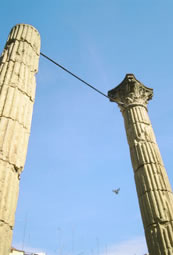
August
Performance of ‘Assumpció de Madona Santa Maria’ in La Selva del Camp (14th and 15 th August)Regarding all the activities related on the festive and cultural calendar of La Selva, the representation of the ‘Assumption of Madonna Saintly Maria’ highlights over the others. It is an assumpcionist mystery of the 14th century which has been retrieved of the parish files and very well interpreted and sung by the people of La Selva in the church of Sant Andreu the 14th and 15th of August. It is an anonymous play of the second half of the 16th century which has left us an important literary, theatrical, musical and religious legacy of the medieval theatre. This is the most ancient assumpcionist drama written in Romance language of Europe that has arrived until our days.
The mystery picks up the traditions that surround the Party of the Virgin of August or La Mare de Déu d’Agost. The central subject of the play - the body and soul Assumption of Maria in the sky - comes from the first centuries of the Christianity. This venerable tradition, of which we already have documentation in the 4th and 5th centuries, it was spread the 13th century by Jaume de Vorànige in his Llegenda Ŕuria.
Like any other medieval Mystery, the performed songs are indicated for the consueta. In the majority of the cases the melodies were borrowed from existing musical sources and they were applied to the dramatic text. Normally they are hymns and religious chants but also they used profane pieces. All the music belongs to the Gregorian or polyphonic repertoire of 13rd and 14th centuries, with the particularity that the majority of the songs are interpreted with the same tune that indicates the consueta of the manuscript.
The Siege of Miravet (7 th and 8 th August)
"The Siege of Miravet" is a play that represents the historical facts that brought the end of the Temple to the Crown of Aragon, among 1307 and 1308. It is based on a rigorous study made by Santi Marsal about the original documentation existing in the Archives of the Crown of Aragon. It picks up the vicissitudes and negotiations among Jaume II and the knights of the Temple of his lordship during the process carried out against the Order and the siege in the castle of Miravet, which lengthened twelve months. With this performance they try to honor the memory of the Red Cross and the sword friars-warriors as well as all those ancestors who sacrificed themselves for the dream of a better future. The Muslim and Jewish population lived with the new Christian men, monks-warriors, being a witness of their step on these lands.
The production of the performance is entrusted to the cultural associations and it is represented in the original place of the facts: the castle of Miravet. The set of actors is divided into the Saracens from Miravet or "morets" - who are representative of the Muslim Jew mosque -, the knights of the Temple, the soldiers and squires of the Templars, the ‘almogàvers’ or Catalan soldiers, the soldiers and representatives of the royal court, the souls in sorrow of the hell and the death of the Apocalypse, as well as the incarnation of the ghost of the Temple’s traitor: Jaume de Garrigans.
Festes Majors or Major Parties
August is the month of the local festivities, ‘envelat’ balls, fireworks and every kind of typical dance - sardanas, jotas, dance of sticks, etc. - in an infinity of villages of the Costa Daurada. These parties take advantage of the weather during this month and many villages celebrate their greatest event of the year: Amposta, La Bisbla del Penedés, Les Cases d’Alcanar, Deltebre, Roda de Barà are some of them.
Approfondimenti
|
FORUM
